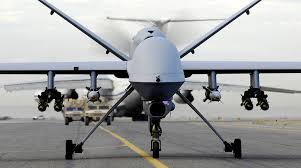As reported by The Verge: Last week, Saudi Arabia bought its first drone fleet, according to a dispatch from Tactical Reports.
Saudi Crown Prince Salman met with Chinese General Wang Guanzhong to
sign a contract for a shipment of Chinese Wing Loong drones, also known
as Pterodactyls. The drones that make up the shipment are designed to
mimic America's Predator drone, with surveillance capabilities and
enough lift to carry two matched air-to-ground missiles.
If the report is true, it means Saudi Arabia may have joined an exclusive club, one of the few nations with armed, unmanned aircraft. It's a group that, to date, includes just the US, Britain, Israel, China, and (depending who you ask) Iran — but beyond those countries, the capability is increasingly available to whoever can pay for it. At the Singapore Air Show earlier this year, both Israel and China were showing off their wares to would-be clients, including the Pterodactyl drone named in the report, and you could find similar displays at dozens of other air shows. With American counterterrorism efforts providing an ongoing test of how valuable the machines can be, there are lots of countries willing to buy.
 International trade barriers
have slowed down the spread, but they haven’t stopped it. For US
companies, combat drones are controlled under the same agreement as
cruise missiles, through an association called the Missile Technology
Control Regime. But China and Israel aren't part of the group, and the
two countries have begun aggressively marketing drone systems to
outsiders eager to keep up with US capabilities. One report from the
consulting firm Frost & Sullivan estimated that Israel had exported
$4.6 billion in drone systems between 2005 and 2012.
International trade barriers
have slowed down the spread, but they haven’t stopped it. For US
companies, combat drones are controlled under the same agreement as
cruise missiles, through an association called the Missile Technology
Control Regime. But China and Israel aren't part of the group, and the
two countries have begun aggressively marketing drone systems to
outsiders eager to keep up with US capabilities. One report from the
consulting firm Frost & Sullivan estimated that Israel had exported
$4.6 billion in drone systems between 2005 and 2012.
If the report is true, it means Saudi Arabia may have joined an exclusive club, one of the few nations with armed, unmanned aircraft. It's a group that, to date, includes just the US, Britain, Israel, China, and (depending who you ask) Iran — but beyond those countries, the capability is increasingly available to whoever can pay for it. At the Singapore Air Show earlier this year, both Israel and China were showing off their wares to would-be clients, including the Pterodactyl drone named in the report, and you could find similar displays at dozens of other air shows. With American counterterrorism efforts providing an ongoing test of how valuable the machines can be, there are lots of countries willing to buy.
The US is still responsible for the vast majority of drone strikes, but that may have more to do with politics than capability. A GAO report from 2012
found that more than 75 countries have some form of drone system. Most
are unarmed but some, like the systems used in Australia, Japan, and
Singapore, could be retrofitted for military purpose. More importantly,
the US’ use of drones — more than 50 strikes in 2013 alone
— seems to have whetted a global appetite for combat drones. "If you
think of this as part of a broader trend of the proliferation of
military robotics, then the idea that we were going to have a monopoly
on this kind of technology was always a bit far-fetched," says
University of Pennsylvania political scientist Michael Horowitz. "The
American monopoly on drones is over and probably never really existed."
Experts also say Saudi Arabia
has previously demonstrated both the interest and the budget for this
kind of purchase. "Saudi Arabia and smaller countries like the UAE are
trying to get their hands on whatever they can, and the US has pretty
restrictive export policies," says Cornell University professor Sarah
Kreps, who studies drone proliferation. The result leaves China as one
of the only sources available in town.
One of the biggest questions is
whether the new generation of foreign drones can match US capabilities.
"We don't know at all about the quality of the pterodactyl," Kreps
cautions, "these aren't combat-tested." Since unmanned aircraft rely so
heavily on satellite and communications infrastructure, it’s hard to
tell from the craft alone how well it will perform in the field. The
Pterodactyl is also typically sold for a fraction of the price of the
Predator, which has only fueled skepticism.
But even if China needs help
to bring its drones up to US standards, that expertise may not be hard
to find. UAVs are built on mostly commercial technology, drawing from
the robotics and aviation industries. That’s much harder to keep under
wraps than military tech like warheads or missiles. As long as there’s a
market, there’ll be an incentive to build cheaper and more powerful
drones, and the club of drone-armed countries will continue to grow. As
Horowitz puts it, "What we know about the history of military technology
suggests it will be really difficult to keep a lid on this."














